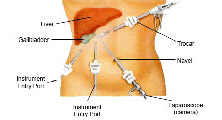Laparoscopic Surgery

Laparoscopic surgery also referred to as minimally invasive surgery describes the performance of surgical procedures with the assistance of a video camera and several thin instruments. During the surgical procedure, small incisions of up to half an inch are made and plastic tubes called ports are placed through these incisions. The camera and the instruments are then introduced through the ports which allow access to the inside of the patient.
The camera transmits an image of the organs inside the abdomen onto a television monitor. The surgeon is not able to see directly into the patient without the traditional large incision. The video camera becomes a surgeon’s eyes in laparoscopy surgery, since the surgeon uses the image from the video camera positioned inside the patient’s body to perform the procedure.
A laparoscopy may be done to find the cause of symptoms such as abdominal pain, pelvic pain, or swelling of the abdomen or pelvic region. Or, it may be done if a previous test such as an X-ray or scan has identified a problem within the abdomen or pelvis. Some common conditions which can be seen by laparoscopy include:
- Endometriosis
- Pelvic inflammatory disease
- Ectopic pregnancy
- Ovarian cyst
- Appendicitis
Common Laparoscopic Procedures
Laparoscopic surgery can be used for various procedures. Some commonly performed operations include:
- Removal of the gallbladder (laparoscopic cholecystectomy). It is now the most common way for a gallbladder to be removed.
- Removal of the appendix
- Removal of patches of endometriosis
- Removal of parts of the intestines
- Female sterilisation
- Treating ectopic pregnancy
- Taking a biopsy (small sample) of various structures inside the abdomen which can be looked at under the microscope and/or tested in other ways.
Benefits of laparoscopic procedures
- Less post operative discomfort since the incisions are much smaller
- Quicker recovery times
- Shorter hospital stays
- Earlier return to full activities
- Much smaller scars
- There may be less internal scarring when the procedures are performed in a minimally invasive fashion compared to standard open surgery.
How is it done?
Laparoscopy and laparoscopic surgery are usually done whilst you are asleep under general anaesthesia. The skin over the abdomen is cleaned. The surgeon or gynaecologist then makes a small incision (cut) about 1-2 cm long near to the navel (belly button). Some gas is injected through the cut to 'blow out' the abdominal wall slightly. This makes it easier to see the internal organs with the laparoscope which is gently pushed through the incision into the abdominal cavity. The surgeon or gynaecologist then looks down the laparoscope or looks at pictures on a TV monitor connected to the laparoscope.
If you have a surgical procedure, one or more separate small incisions are made in the abdominal skin. These allow thin instruments to be pushed into the abdominal cavity. The surgeon or gynaecologist can see the ends of these instruments with the laparoscope and so can perform the required procedure.
When the surgeon or gynaecologist has finished, the laparoscope and other instruments are removed. The incisions are stitched and dressings are applied.
